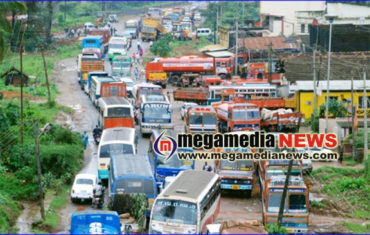Mangaluru City: Inadequate and collapsing infrastructure
12:33 PM, Thursday, May 3rd, 2018
Mangaluru: More than one third of the population of Dakshina Kannada, resides in urban Mangaluru which is spread over three Assembly constituencies. But the city is filled with inadequacies including crumbling infrastructure, unregulated public transport, unfinished underground drainage system and unplanned concrete roads.
Mangaluru is a hub of commercial and educational activities and its growth has increased drastically in the last two decades, the lack of foresight among successive administrations to augment infrastructure appears to have caused the gridlock for infrastructure augmentation. The city has also been chosen to be developed as a smart city.
As a result, Mangaluru now has several well laid concrete roads with poor planning. These roads lack shoulder drains, pavements and utility ducts. Lack of properly designed water supply and drainage system fails to utilize the cities two perennial rivers. Many high-rises have turned up on the skyline of the city only with no adequate parking space. There exists ample number of buses accompanied by lack of a planned public transport system.
Bitumen roads in the central part of the city, which used to get damaged during the monsoons, have been replaced by concrete roads. But, the concrete roads have been built with no provision for shoulder drains at many places resulting in rainwater flowing on roads during the monsoon, consequently leading to their damage and increase the probabilities for accidents.
The absence of shoulder drains also resulted in denial of walking space for pedestrians as otherwise drain-covers would have provided that space.The concrete was laid over the existing and aged water lines which frequently rupture thereby forcing the Mangaluru City Corporation to cut open portion of the concrete to fix leaks. No ducts have been provided to lay utility lines.
Mangaluru was one among many coastal cities chosen to strengthen the underground drainage network through Asian Development Bank-funded Karnataka Urban Development and Coastal Environment Management Project (KUDCEMP) in 1999.
After two decades and the expenditure of 400 crore rupees, only two of the four sewage treatment plants, Kavoor and Pachchanadi are functional, while the other two Jeppinamogaru and Surathkal are non-functional as the underground drainage network in the region is not connected to them. Their infrastructure is decaying and the coastal eco-system of the Netravati and Phalguni is being endangered, as polluted as waste water flows into the rivers.
Mangaluru is dominated by the presence of private bus services. There are over 350 buses, both private and KSRTC, operating as city services but there is a major lack for a robust and synchronised public transport system for the city.
Nearly 300 buses of the 350 buses providing service, operate from Hamilton Cirlce as the centre, while services connecting different parts of the city are unavailable. With different private operators, the travelling public has no option to change buses with the help of passes, daily or monthly, as provided by road transport corporations.
The administration had been talking of a satellite bus terminal to de-congest the city and earmarked about seven acres of land near Pumpwell (Bhagwan Mahaveer) Circle off National Highway 66, but still remains on paper.
Along with the city, the fringe areas in the region, including Ullal, Someshwara, Mudipu and Konaje under Mangaluru and Surathakl under Mangaluru North, also face problems related to garbage disposal, drinking water and underground drainage system.
There are nearly five lakh registered vehicles in Mangaluru. However the available road infrastructure in more used for vehicular parking. Also, parking lots in basements of many high-rises arebeing illegally converted into commercial spaces.
There are over 160 such high-rises identified by the city corporation for having violated building by-laws. Former Mayor Kavitha Sanil had in January this year assured of taking action against at least 25 buildings after issuing notices, but no further action followed the words.
Vehicles are being parked on roads and even on whatever available pavements, causing a nightmare to pedestrians and choking vehicular movement.
The multi-level car parking facility at Hampanakatte at old bus stand remains a non-starter.
Simillar Posts
Warning: count(): Parameter must be an array or an object that implements Countable in /home/megamcaq/public_html/wp-content/plugins/post-plugin-library/common_functions.php on line 357
- None Found
Leave a Reply
© Copyright 2008 www.megamedianews.com All Rights Reserved. Privacy Policy








 Posted in
Posted in  Tags:
Tags: 



